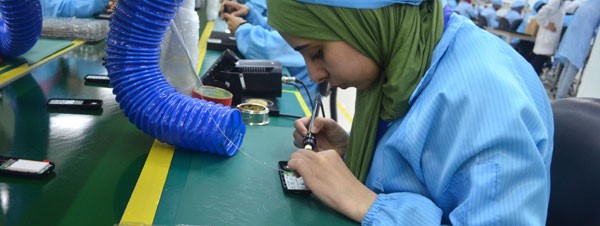“There are no local players in this market, a fact that allowed us to request a large percentage of payment upfront with no guarantees,” says David Youssef, CEO of EgyRobo, a Cairo-based company that develops robotic solutions. “I was able to scale my business with no external funding due to the lack of competition and uniqueness of our offerings.” Launched four years ago, Youssef believes EgyRobo is the only company of its kind operating beyond the startup-phase in Egypt.
Youssef’s story suggests a lucrative untapped market, begging the question: Why aren’t there more players in the robotics industry in Egypt?
Globally, artificial intelligence (AI) is progressing much faster than most research forecasted a decade ago. According to a 2018 report by PricewaterhouseCoopers (PwC), AI is projected to become a $15.7 trillion industry by 2030. Locally, the case appears to be similar for AI, with the same report estimating its contribution to Egypt’s gross domestic product (GDP) at 7.7 percent by 2030.
Zooming in on robotics, which is a relatively small slice of the AI sector, the story appears to change. “In Egypt, most innovation-focused startups are working on mobile applications and software, with only a minority working on robotics,” says Hossam Osman, adviser for innovation and training at the Ministry of Communication and Information Technology (MCIT).
Alaa Khamis is an AI expert and founder and chair of the Egyptian chapter of the IEEE Robotics and Automation Society (RAS), an association working to promote robotics in Europe, the Middle East, and Africa. Khamis believes robotics lags in developing countries in general due to many obstacles, chief among them are the misconceptions about its application and economic impact. Robotics in Egypt, he says, is viewed as expensive humanoids, a fact that has slowed the adoption of innovative technology, especially in manufacturing.
“In Egypt, there is a common belief about the negative effect of modernizing factories with advanced robotic [technology] on the overproduction-underemployment dilemma,” he explains, adding that the lack of initiatives to help grow this segment comes from the perception—exaggerated by the media—-that robotic technology is limited to replicating how humans look and act.
Robotic applications go beyond Sofia, the famous humanoid Saudi citizen. The need for robotics is most common in sectors that are less focused on technology, such as agriculture or retail. The PwC report ranks healthcare as the sector with the most robotics potential.
Egypt, however, would benefit significantly from even a straightforward robotic upgrade of its industrial sector, says Khamis. “According to the World Bank, manufacturing contributed only 16 percent of Egyptian GDP in 2017, a much lower percentage in comparison to [other regions, such as] the 28 percent contributed in East Asia and the Pacific in the same year.” He argues Egypt could match that higher percentage with even simple robotic upgrades.
Given such a huge potential, the limited presence of local robotics developers begs a closer look.
It’s a Culture Thing
Ahmed el Daly, co-founder and managing director of SAND Product Design, a company that develops electronic and technical aspects of robotic machines, believes the main issue is market readiness. “Simply put, the culture isn’t there,” he says. “Very few companies want to invest the funds needed to adopt robotic applications in their line of work, with none existing beyond the industrial sector.”
Since starting the company with his partner, Mohamed el Sharawy, in 2016, they have encountered no interest in robotics beyond industrial applications. “There isn’t real demand or awareness of the possibilities in the Egyptian market,” he says. “The rest of the world is turning to more value-added applications, such as in medical care and other areas requiring comprehensive human interaction.”
Ahmed Abdel Baky, founder and managing director of InnoVision Systems, a robotics-focused solution provider, sees local culture as “the ultimate challenge facing the growth of the robotics industry in Egypt.” He explains that clients seeking robotic technology have a hard time accepting that Egyptian companies adhere to international standards. Abdel Baky singles out the perception of value as the main issue. “Our pricing formulas also follow an internationally adopted process, which of course leads to a relatively cheaper cost than international companies due to the cost of local manpower,” he says. “Clients, however, perceive locally developed products as inferior in quality and thus should cost only a fraction of European-developed products.”
Going Back to Basics
Osman, however, thinks education is the main issue. “The challenge with disruptive (new) technology is its short lifecycle,” he says. “For universities to cope with such speed in innovation, they need to develop at a very fast pace, something that does not fit with the current Egyptian curriculum development process.”
He explains it is a common belief among startups that a competitive edge comes from being a “first mover”: developing new applications rather than utilizing the latest existing technology. “To foster growth and compete in the market, an SME (small or medium-sized enterprise) needs to learn how to develop sustainable models that can outlast the short life cycle of technological development,” he adds. “We need to inject both the latest technology and the business know-how of sustainable innovation models in our education systems to address both these needs.”
Furthermore, Khamis notes, the role of educating the masses and raising awareness of the value of robotic technology in improving the local cultural limitations and market potential.
Beyond R&D
“There are a lot of ideas in universities, but they rarely move beyond that level,” says SAND’s el Daly, citing businesses’ lack of awareness of their value.
Osman agrees, saying, “The business sector’s contribution to R&D (research and development) is very minimal, insignificant. The academic contribution to the needs of businesses is also insignificant.” There is a huge gap, “therefore, this industry is mainly growing through government initiatives and independent entrepreneurs,” he adds.
Khamis, however, believes the primary challenge in bridging the gap is developing products beyond the proof-of-concept phase. “There is a big difference between a working prototype developed at a university or a research institute and an actual commercial product to be used by the public,” he says. Working on a proof-of-concept is “solving a problem in certain predetermined and sometimes unrealistically oversimplified conditions.” He adds that development of a commercial product goes beyond this phase significantly in regard to functionality, scalability, user experience, and other aspects.
As a means to bridge the development-commercial gap, Khamis says, “technology transfer offices at universities, incubators, and tech accelerators could play a crucial role in facilitating the conversion of working prototypes into actual products and in commercializing the innovation.”
Part of fostering an economic environment that allows robotics-focused companies to grow beyond the startup phase is boosting demand, according to Osman. “We need to develop local products that encourage private companies and government entities to adopt more technology in their operations,” he says. “The ministry of planning has a program for enhancing technology reliance (digital transformation) of government bodies.”
However, Osman argues, scalable deployment in government bodies is impossible without developing innovative technology that can be functionally applied on a large scale.
A Matter of Legalities
On the private side, companies such as EgyRobo have been able to scale up even beyond Egypt’s borders. According to Youssef, the Cairo-based company now has contracts in Bahrain, Sweden, Saudi Arabia, and Kuwait.
While the company relied mainly on the lack of competition to grow, Youssef says, legal limitations were a huge roadblock. “Launching the company took four years due to paperwork,” he recalls. “Manufacturing robotics is not a term in Egypt’s legal framework. It took us time to agree on the nature of our business with authorities.”
InnoVision Systems’ Abdel Baky had a similar experience. “Robotics as a sector—or even a term—does not exist in Egypt’s legalities,” he says. “Most companies work within the system, filing under categories that allow them to legally operate.” A core part of InnoVision Systems is importing electronic components, he says, thus “we ensured that our legal status allows us to do that.”
Legal accountant Mohamed Abdalla notes this predicament is not limited to robotics. “The operations of many companies now tend to be more fluid, rather than limited to a certain narrowly defined function,” he says. “This is why we now register companies in a way that allows them to legally practice a wide range of activities and even expand in the future.”
The Ministry of Investment and International Cooperation has been working to address the issue, according to Abdalla. “While things are much better, we still face many challenges in this regard.”
Registering a robotics-focused company is only one of the legal issues. Abdel Baky identifies imports of components as a major hurdle. “We import most of our needs, from sensors to very sophisticated equipment. However, we pride ourselves on being able to resolve the many issues in importing components legally into the country,” he says. “Of course, it all depends on what you import. A lot of items you can’t bring in, but their components are allowed entry.”
In an attempt to limit reliance on imports and lengthy delays in the process, Abdel Baky is working on assembling parts of his needs in Egypt. “Instead of importing entire components, we now handle the mechanical work locally,” he says, “which allows us to import only a portion of the needed parts.”
For EgyRobo, which services the defense industry, securing imports of components is a much more complex issue. “Some components we need are not legal to import, such as radio frequency equipment, communication devices, explosive detectors, and flight controllers, to name just a few,” he says. “We work with the government to obtain exceptions, due to the nature of our scope. Of course, all these steps require a lot of time, which in the business world is very costly.”
Most of EgyRobo’s dealings are conducted on an “individual exception basis with the Industrial Development Authority,” according to Youssef. “Our needs keep developing and therefore we continuously face a lot of issues with our import licensing.”
The government, according to Osman, has been taking steps to ease legal challenges faced by technology companies in all sectors, such as the Incentives for Innovation in Science and Technology law. The law was ratified in April, however, its executive regulations have yet to be determined. This legislation establishes a framework for legalizing and commercializing innovation, and allows universities to launch companies, “a move that can help turn graduation projects into startups,” he says.
“Moreover, it has become legal to have single-ownership companies in Egypt for the first time,” says Osman. “This amendment should allow small-scale innovators to comfortably exist in the market.”
For security reasons, however, many components will remain illegal to import and trade in, Osman explains. “Drones are on top of the list. You technically can license a drone,” he says. “With lengthy paperwork and [security] approvals, though, it is a very tough process.”
Other components, such as hardware and sensors, are legal to import, according to Osman. However, approvals take long time, and the nature of entrepreneurship requires speed.
“These issue are being addressed by the government, but things are moving a bit slow,” he adds.
Funding Challenges
Another crucial challenge to the existence and growth of the robotics sector is funding. Khamis believes the lack of financing opportunities at universities is why “many amazing prototypes don’t make it to the market.”
“Investors in Egypt in this sector are very few,” agrees Osman. ‘We don’t have sufficient angel investors or venture capitalists interested in this industry, which significantly limits potential funding for startups. True, the ministry of investment and government in general have launched initiatives to address this issue, yet the pool still is very small.”
In a company’s business cycle, the main vulnerability — dubbed Death Valley — tends to occur as management begins to scale up its production, explains Osman. “This is the phase with the highest risk,” he says. “Once a company passes this phase, it becomes relatively easier to secure funding.”
Furthermore, funds needed for robotics companies tend to be significant, according to Youssef. That renders banks an unsuitable option. “There was a period when the economic situation impacted our clientele and thus our business,” says Youssef. “During this phase, I considered securing funding from banks, but the finances required were too high.”
Human Capital
Building an adequate pool of skilled employees is a relatively less-significant challenge. Youssef visits robotic events conducted by universities as well as different labs to scout for talent. However, he notes a lack of awareness of the specific skills needed by the private sector. “I train anyone I hire from scratch,” he says. “The average employee goes through one year of training.
For Abdel Baky, the local skill-set requires only training. “We have excellent capabilities in our engineers and technicians.”
Khamis agrees, saying, “There is a high number of highly qualified personnel in robotics. However, there is a gap between what students study and what is done in the industry.”
Moreover, he sees little room for young talent to be creative and innovative. “Even businesses utilizing the latest technology limit the use of local talent to tasks involving operation of equipment,” he explains.
Other than technical skills, Abdel Baky sees a significant lack of candidates with the right skills to market and position robotics. “We need people with the skills to convey the right message, that these products are needed in every business,” he says. “This is the real skill gap, in my opinion.”
Moving Forward
Despite its many challenges and few players, those interviewed agree the industry will grow, partly in response to global dynamics and partly as local stakeholders continue to address the market’s shortcomings such as culture and the legal framework.
“I am highly optimistic about the future of the robotics industry in Egypt,” says Khamis. “A shift can be observed, it is only a matter of time.”







